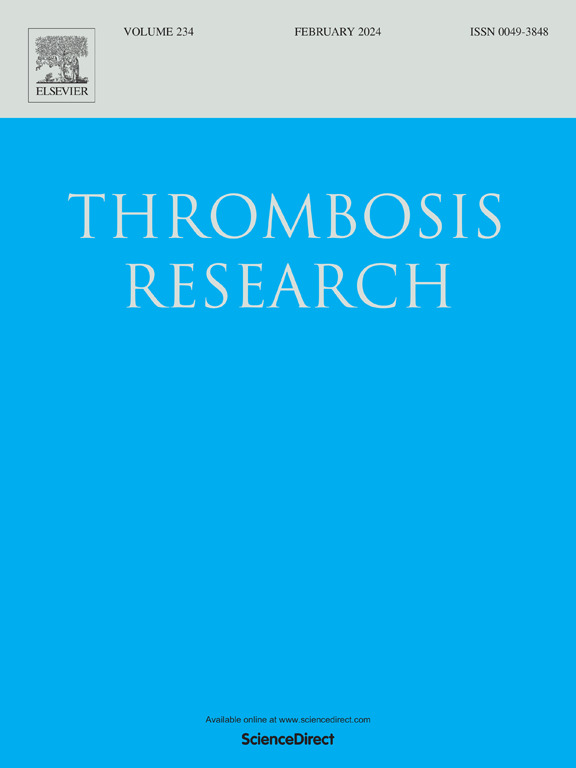CIB1和血小板整合素α ib β3:分子机制、破坏策略和抗血栓机会
IF 3.4
3区 医学
Q1 HEMATOLOGY
引用次数: 0
摘要
血小板整合素α ib β3是动脉血栓形成的最后一种常见效应:它从低亲和力状态切换到高亲和力状态,结合纤维蛋白原,启动外向内信号,稳定不断增长的血栓。钙与整合素结合蛋白1 (CIB1)作为αIIb细胞质尾部的第一个内源性伙伴出现,现在被认为是一个双重作用的适配器。在休息时,无Ca2+的CIB1拴住内膜扣并抑制过早的整合素激活;配体结合后,Ca2+结合的CIB1与αIIb对接,招募黏附激酶并放大src依赖性细胞骨架重塑。基因缺失解除了这些阶段- CIB1 - / -血小板正常聚集但不能扩散,产生不稳定的动脉血栓,仅适度延长出血时间-从而验证了CIB1 -αIIbβ3界面作为选择性抗血栓检查点的作用。结构研究揭示了一个锁存槽机制,其中Ca2+暴露释放了CIB1上识别αIIb GFFKR基序的疏水口袋。这个口袋现在锚定低纳摩尔大环肽和第一代小分子,取代CIB1,阻断外向内信号传导,抑制人类血小板聚集,而不占用整合素的配体结合位点。除血小板外,CIB1还调节其他α-整合素,驱动病理性血管生成,并支撑致癌AKT和ERK通路,这表明治疗机会和安全性考虑。未来的重点包括全细胞质复合体的高分辨率结构、与talin/kindlin的实时竞争动力学、药物先导物的效价优化以及血栓和癌症模型的体内验证。总的来说,这些进展可以开创一类新的抗血小板药物,在保持生理性止血的同时抑制病理性凝块生长。本文章由计算机程序翻译,如有差异,请以英文原文为准。
CIB1 and platelet integrin αIIbβ3: Molecular mechanisms, disruption strategies and antithrombotic opportunities
Platelet integrin αIIbβ3 is the final common effector of arterial thrombosis: it switches from a low-affinity to a high-affinity state, binds fibrinogen, and initiates the outside-in signals that stabilize a growing clot. Calcium- and integrin-binding protein 1 (CIB1) emerged as the first endogenous partner of the αIIb cytoplasmic tail and is now recognized as a dual-role adaptor. At rest, Ca2+-free CIB1 tethers the inner membrane clasp and restrains premature integrin activation; after ligand engagement, Ca2+-bound CIB1 docks onto αIIb, recruits focal-adhesion kinase and amplifies Src-dependent cytoskeletal remodeling. Genetic deletion uncouples these phases—Cib1−/− platelets aggregate normally but fail to spread, yielding unstable arterial thrombi with only modest prolongation of bleeding time—thereby validating the CIB1–αIIbβ3 interface as a selective antithrombotic checkpoint. Structural work reveals a latch-and-groove mechanism in which Ca2+ exposure frees a hydrophobic pocket on CIB1 that recognizes the αIIb GFFKR motif. This pocket now anchors low-nanomolar macrocyclic peptides and first-generation small molecules that displace CIB1, block outside-in signaling, and inhibit human platelet aggregation without occupying the integrin's ligand-binding site. Beyond platelets, CIB1 modulates other α-integrins, drives pathological angiogenesis, and scaffolds oncogenic AKT and ERK pathways, indicating both therapeutic opportunities and safety considerations. Future priorities include high-resolution structures of the full cytoplasmic complex, real-time competition kinetics with talin/kindlin, potency optimization of drug leads, and in-vivo validation in thrombosis and cancer models. Collectively, these advances could inaugurate a new class of antiplatelet agents that temper pathologic clot growth while preserving physiological hemostasis.
求助全文
通过发布文献求助,成功后即可免费获取论文全文。
去求助
来源期刊

Thrombosis research
医学-外周血管病
CiteScore
14.60
自引率
4.00%
发文量
364
审稿时长
31 days
期刊介绍:
Thrombosis Research is an international journal dedicated to the swift dissemination of new information on thrombosis, hemostasis, and vascular biology, aimed at advancing both science and clinical care. The journal publishes peer-reviewed original research, reviews, editorials, opinions, and critiques, covering both basic and clinical studies. Priority is given to research that promises novel approaches in the diagnosis, therapy, prognosis, and prevention of thrombotic and hemorrhagic diseases.
 求助内容:
求助内容: 应助结果提醒方式:
应助结果提醒方式:


